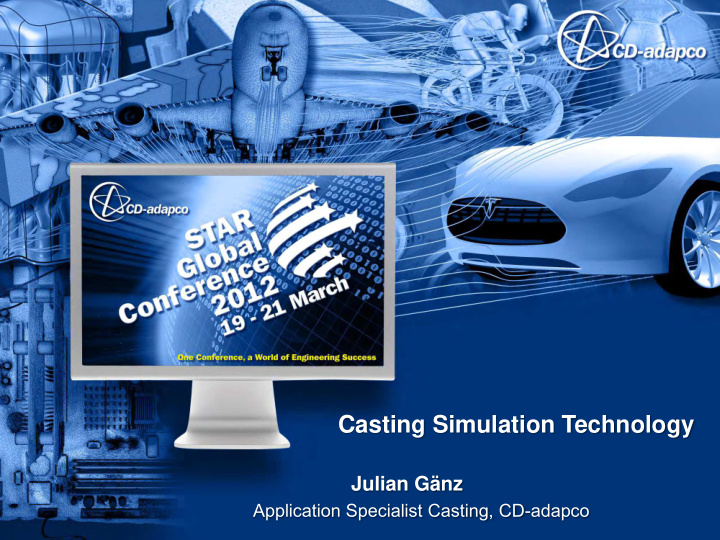



Casting Simulation Technology Julian Gänz Application Specialist Casting, CD-adapco
Casting materials Market Overview [Mio tons] Grey Iron 13,6 38,16 9 Ductile Iron Steel 19,4 Non Ferrous alloys From Modern Casting “ 2010 world census casting production” Density Cost/tonne Material Relative [kg/m3] [$] Carbon Steel 7820 550 1 Cast Iron 7225 830 1,51 Aluminium/alloys 2700 2220 4,0 Titanium /alloys 4500 17 000 30,9
Need for Casting Simulation Aluminium Casting Hard Casting Processes 200000 160000 Gravity Die or Sand Tool Cost 120000 [$] Casting 80000 Tilt – Casting 40000 Ease of Centrifugal Casting 0 Engineering Easy changes Low Pressure, Counter- Pressure-Casting High Pressure Die Casting From Austin Group 2002 Precision Casting • Sophisticated materials and geometries Lost Foam call for advanced casting processes Continuous Casting • Requirements for simulation Vacuum Casting – Mold filling with solidification – Defect Prediction – Design tool to help the casting vendor to evaluate the filling and solidification process
Strategic Partnership • Best of both worlds – Provide state of the art of casting simulation solution by combining the engineering experience of two companies which have a long-standing track record in providing CAE solutions and casting processes for over 25 years – Established casting solution STAR-Cast
STAR - Cast • First released in 2009 • Dedicated design and engineering tool for the casting engineer • Process orientated GUI Casting Processes • Core -Capabilities Gravity Die or Sand Casting • Multiphase - liquid, solid and gaseous phases Tilt -Casting, Centrifugal • Resolution of the molten flow and filling front • Model the molten material in its semi-solid state Casting • Dedicated material database Low Pressure, Counter- • Uses STAR-CCM+ state of the art meshing Pressure-Casting technology High Pressure Die Casting Precision Casting
Goal of STAR-Cast development • Further reduce the development time for new or complex casting processes • Broaden the applicability of the casting solution • More materials • More processes • Flow, thermal and solidification simulation in one tool
The Process • Easy to learn • Quickly adaptable to simulation needs • Any given CAD data • 3D-CAD Modeller Geometry • VOF • Isothermal- gating design • Fluid /Solid Interfaces Filling • Thermal - cooling/ solidification • Appropriate meshing models • Particles/ erosion Mesh • Progress of Solidification • Adapt to simulation goal Solidification • Influence on flow • Expandable • Misruns and cold shut Physics • Transient Postprocessing • Piston Motion • Criteria functions, defect analysis Motion • Tilting Post processing • Rotation
Challenges - Meshing • Multi region problem – Complex Geometry – Fluid Cavity – Surrounding Air – Different solids ( mold, cooling iron ..) .. Calls for a strong and powerful meshing solution: • Easy surface repair • Multi region Volume meshing • Volume meshing with integrated prism layer generation • Quick volumetric refinement for thin walled castings
Solidification • Mushy Zone Model – Transition from liquid to solid leads to partially solidified areas – Takes into account the material specific fraction solid curve • Slurry Zone – Grains of solidified material form areas of solidifying material hindering the flow • Flow Stop – Complete stop of flow in solidified areas
Casting Material Database • A dedicated Material Database is available in STAR-Cast, pooling all relevant material information for the casting engineer • Material comparison • Temperature depended • Recommended datasets • Fully documented • Database expandable • Import or change datasets • Explicit usage rights • Confidentiality ensured
Defect prediction: Criteria Functions • Used to deduct additional information about the solidification process • Based on temporal and spatial temperature distribution • Gather Temperature gradients, cooling rates and local solidification times • Compute criteria functions, such as Niyama or G/v criterion • Estimate microstructure characteristics
Investment Casting: Shell generation • For precision casting – Ceramic mold is created by dipping a wax model into a ceramic based slurry – Ceramic slurry dries and builds the mold for the casting – The wax is removed in an autoclave
Investment Casting: Shell generation • Workflow – Start with your wax model – Define the shelling parameters • Example: Turbine Blade – Automated process – 4 mm shell thickness – Computational time ~250 s for shell generation and meshing – Conformal mesh between fluid and mold – ~345.000 cells
Sand Casting: Phase selective wall porosity • Phase selective wall porosities for VOF- Phases – Capture the venting effect of a porous mold ( i.e. Sand)
Looking ahead • Provide more accuracy, robustness and ease of use for a wider range of casting processes • Include further solidification models – Ductile Iron, Grey Iron – Composite castings • Visit Access at their booth to get in touch with our experts and learn what can already be done today • Casting Webinar – Updating you on our casting capabilities
Recommend
More recommend